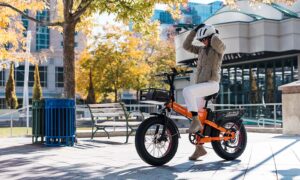
Electric bikes, or eBikes, have gained widespread popularity for their ability to combine traditional cycling with advanced motorized assistance. Whether for commuting, leisure, or fitness, eBikes cater to a variety of needs and lifestyles. One common question people have is whether you actually need to pedal an eBike or if it can function entirely on motor power.
The answer depends on the type of eBike and its features. Some eBikes are designed to assist pedaling, while others have throttles that allow for motor-powered riding without pedaling. This article dives into how eBikes work, the types of assistance they offer, and the rules surrounding their use, helping you decide if an eBike is right for your riding style.
Let’s have a look:
How Electric Bikes Work
eBikes are equipped with an electric motor, a battery, and a control system to provide varying levels of support to riders. These components work together to offer a smoother, more manageable ride compared to a traditional bike. Pedal-assist modes activate the motor as you pedal, giving you extra power for tasks like climbing hills or riding long distances with less effort.
The main goal of electric bikes is to enhance the cycling experience rather than replace traditional pedaling altogether. Some eBikes also feature a throttle mode, which allows the motor to power the bike without pedaling. This versatility makes eBikes an attractive option for people with different fitness levels, commuting needs, or recreational preferences.
Types of Pedal Assistance and Throttle Options
eBikes offer a variety of modes, allowing riders to tailor their experience based on the situation. Pedal-assist eBikes provide motor support as the rider pedals, with adjustable settings for different levels of assistance. Lower settings are ideal for flat roads or light riding, while higher settings are helpful for steeper inclines or longer trips. Riders maintain the feel of traditional cycling with a boost when needed.
Throttle-equipped eBikes offer another layer of flexibility. These models can be operated without pedaling, making them suitable for riders who want a more relaxed experience or who may have physical limitations. Throttle mode can also be handy in stop-and-go traffic or when accelerating from a standstill. Both pedal-assist and throttle options cater to a wide range of riders, from fitness enthusiasts to those seeking a more convenient way to travel.
Legal Regulations Around Pedaling and eBikes
The legal framework for eBikes varies depending on location, so understanding the rules is important for safe and lawful riding. In the United States, eBikes are typically classified into three categories. Class 1 eBikes provide pedal assistance only, with a maximum speed of 20 mph. Class 2 eBikes include throttle capability, allowing for motor-powered riding without pedaling, also capped at 20 mph. Class 3 eBikes are pedal-assist only and can reach speeds of up to 28 mph.
Local laws may impose additional restrictions, such as helmet requirements, minimum age limits, or specific paths where eBikes are permitted. Some countries may also require licensing or registration for certain eBike models. Being informed about these regulations ensures riders can fully enjoy their eBikes without running into legal trouble.
Benefits of Pedaling an Electric Bike
Pedaling an eBike offers more than just a way to move forward—it adds physical and mental health benefits to the experience. Even with motor assistance, riders still engage in exercise, which improves cardiovascular health, strengthens muscles, and promotes overall fitness. For those who may find traditional bikes too challenging, eBikes provide an entry point to active living while still offering a level of effort that fits their needs.
Additionally, pedaling can extend the battery range of an eBike. The more you pedal, the less the motor has to work, which conserves battery life for longer trips. This makes pedaling especially useful for riders who plan to cover extended distances or explore areas without charging stations. Combining exercise with practicality makes pedaling an integral part of the eBike experience for many riders.
Scenarios Where Pedaling May Not Be Necessary
While pedaling enhances the eBike experience, there are times when using the motor without pedaling can be more practical. Throttle mode is particularly useful when tackling steep hills, carrying heavy loads, or navigating stop-and-go traffic. In these situations, motor power allows riders to maintain momentum without overexertion, making their journey more comfortable and efficient.
For riders with physical limitations or temporary injuries, throttle-equipped eBikes provide a way to stay mobile without the physical strain of pedaling. Whether recovering from an injury or simply needing a break during a long ride, the option to rely on motor power adds versatility and inclusivity to eBike usage. This flexibility makes eBikes an excellent choice for diverse riders and scenarios.
Choosing the Right eBike Based on Your Needs
Selecting the right eBike is key to determining whether pedaling will play a significant role in your rides. Commuters may benefit from a pedal-assist model with moderate motor support for daily travel, while riders seeking a leisurely experience might prefer a throttle-equipped eBike for minimal effort. Off-road enthusiasts may prioritize rugged frames and higher motor power to handle challenging terrains.
Test-riding different models is an effective way to understand their features and find the best fit for your needs. Consider factors like terrain, distance, and intended use when making a decision. Choosing an eBike that aligns with your lifestyle helps you make the most of its features, whether you plan to pedal actively or rely on motor assistance for convenience.
Whether you choose to pedal actively, rely on throttle mode, or combine both, eBikes cater to a wide range of lifestyles and scenarios. Pedaling provides exercise and extended battery life, while motorized assistance adds convenience and accessibility for challenging rides. Understanding the types of eBikes, their assistance options, and local regulations ensures a smoother and more enjoyable experience. As eBikes continue to evolve, their ability to adapt to different riding styles highlights their role as a game-changer in transportation and recreation.





